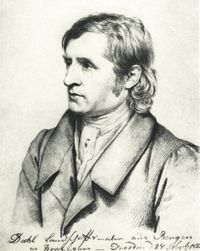Johan Christian Clausen Dahl
The Norwegian landscape painter Johan Christian Clausen Dahl (Bergen, Norway 1788 – 1857 Dresden) arrived in Dresden on September 28, 1818. He was on his way from Copenhagen to Rome and Naples, but he decided to settle in the Saxon residence city for two years. From the beginning, he formed a close friendship with the 14 years older Caspar David Friedrich, which lasted until Friedrich‘s death.
After returning from Italy, Dahl and his first wife, Emilie von Block, moved in April 1823 into the house at An der Elbe 33, where Friedrich and his family had been living since the summer of 1820. The close proximity fostered the intensive exchange between the two complementary romantic painters, who were close in their shared artistic vision. However, while Friedrich created complex landscape pictures with symbolic content in a more detailed painting style, Dahl represented a realism that captured the atmospheric with a lively, impasto application of color.
In 1826, Dahl embarked from Dresden on the first of his five extensive trips to Norway, returning with a wealth of nature studies that he developed into realistic landscape paintings of untamed Nordic nature in his Dresden studio. Like Friedrich, Dahl was only appointed professor of landscape painting by the Dresden Art Academy in 1824 after long hesitation. However, this position was not associated with an academic teaching post in either case. Instead, both painters received artists from all over Europe at the house at An der Elbe 33, including many who oriented themselves to the motifs and artistic expressions of Dahl and Friedrich.
After Friedrich‘s death, Dahl dedicated himself to preserving his friend‘s work and sold Friedrich‘ s painting Two Men Contemplating the Moon to the Dresden Gemäldegalerie (Picture Gallery) in 1840. Dahl died on October 14, 1857, and was buried in the nearby Elias Cemetery. In 1934, his remains were reburied in his birthplace at St. Jakob Cemetery in Bergen.
